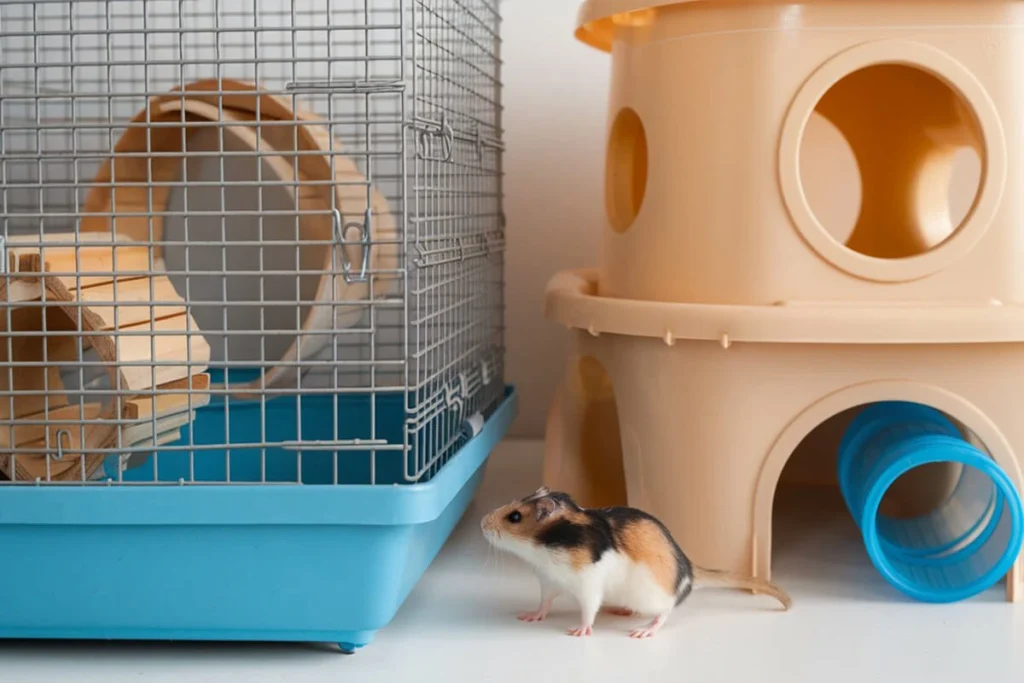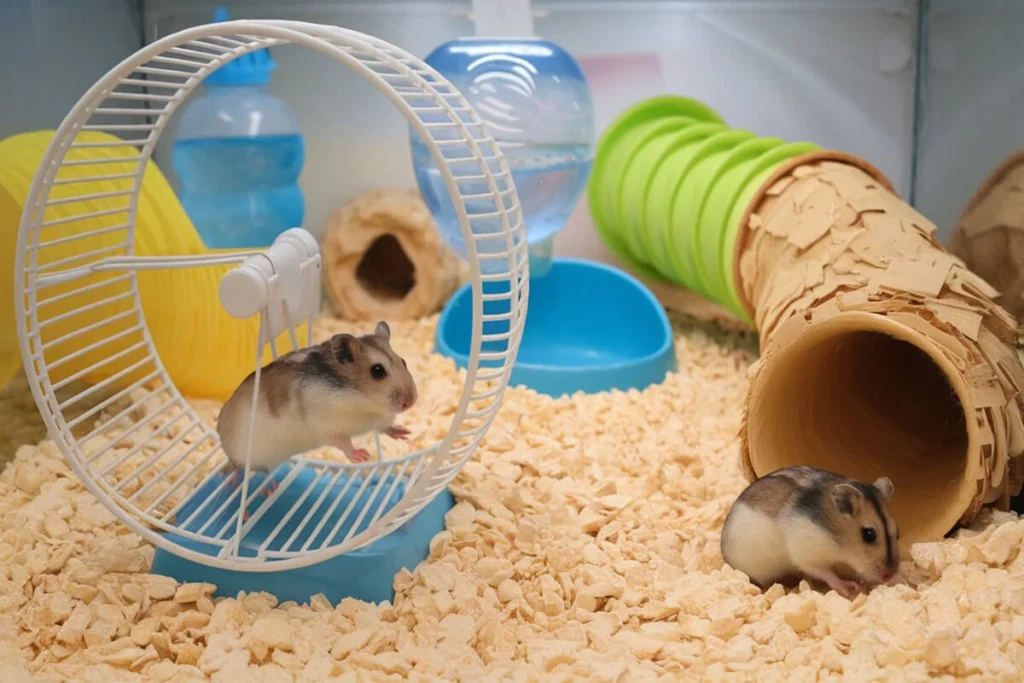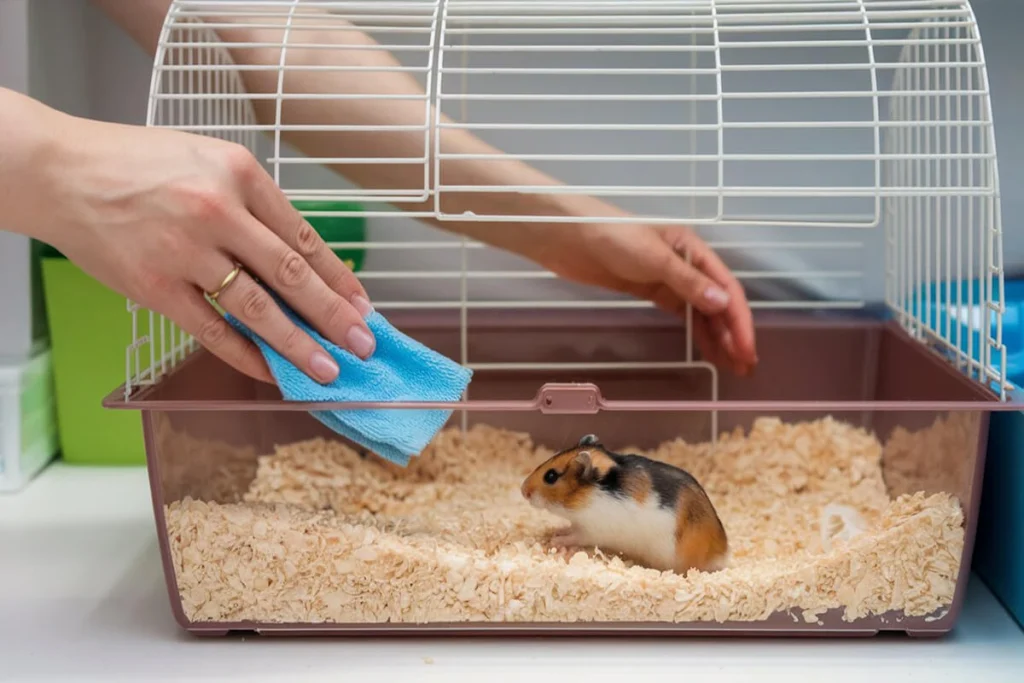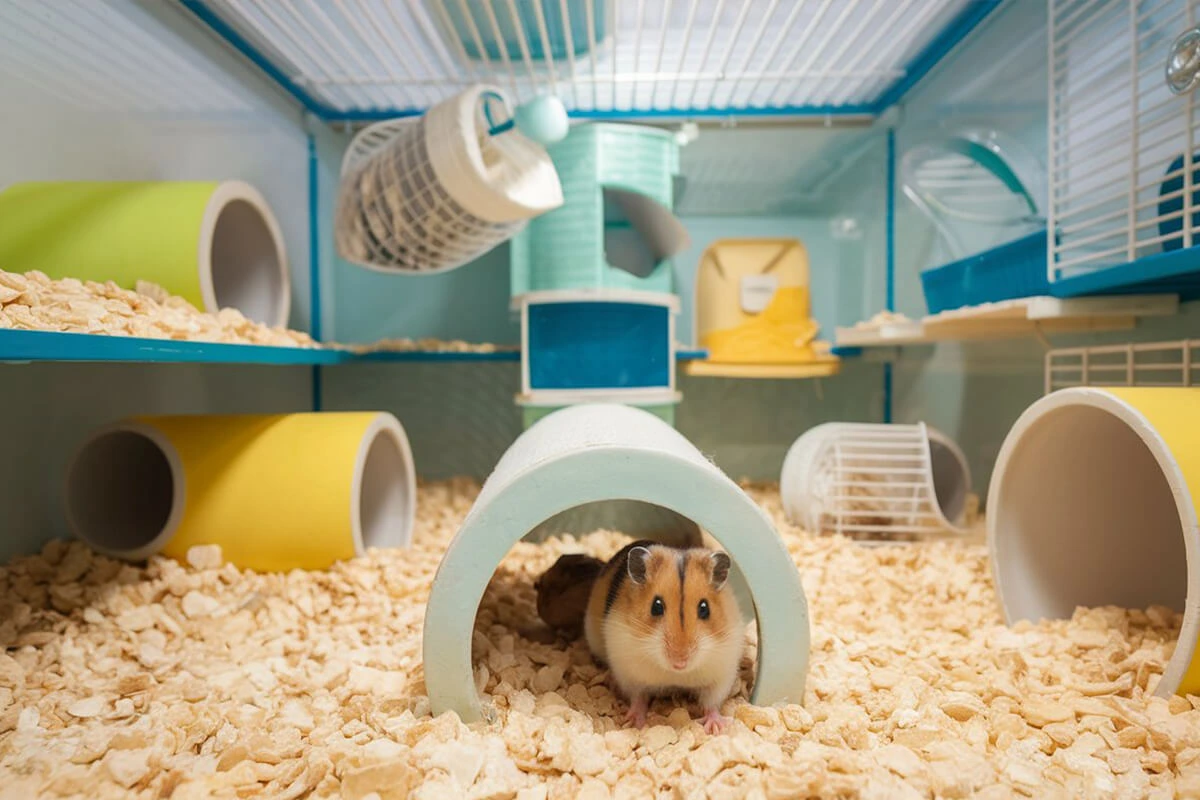Choosing the Best Hamster Cages is one of the most important decisions you can make for your furry friend. A well-designed cage provides a safe, comfortable, and stimulating environment that supports your hamster’s physical and mental well-being. Without the right habitat, your pet may experience stress, boredom, or even health issues. That’s why selecting the perfect enclosure goes beyond just picking a cute design—it requires careful consideration of space, ventilation, safety, and accessibility.
Hamsters are naturally active and curious creatures, so they need a cage that offers plenty of room to explore, climb, and burrow. The right cage should also include essential accessories like a hamster wheel, tunnels, a water bottle, and proper bedding material to ensure a happy and healthy lifestyle. Whether you’re looking for a large hamster cage, an escape-proof design, or an easy-to-clean setup, this guide will help you find the perfect home for your small pet.
In this article, we’ll explore the five best hamster cages that provide the ideal balance of comfort, security, and functionality. We’ll also highlight key factors such as bar spacing, multi-level designs, and affordable options to help you make the best choice. Let’s dive into the top hamster cages that will keep your little companion safe and happy!
Spacious and Comfortable: Large Hamster Cages
Why Size Matters For The Best Hamster Cages
Hamsters may be small, but they need plenty of space to thrive. Many store-bought cages are too small and restrict movement, which can lead to stress and health problems. A properly sized cage allows your hamster to run, burrow, and explore, mimicking its natural environment.
The minimum cage size depends on the type of hamster you have. Syrian hamsters, the largest species, need at least 450 square inches of continuous floor space, while dwarf hamsters require a minimum of 360 square inches. However, bigger is always better. A spacious cage reduces boredom, encourages exercise, and prevents aggressive behaviors caused by overcrowding.
Multi-Level Cages
Multi-level cages add excitement and variety to your hamster’s habitat. Platforms, ramps, and tunnels encourage climbing and exploration, providing mental stimulation. These levels also create separate spaces for different activities, such as sleeping, eating, and playing.
However, you need to ensure safety when choosing a multi-level cage. Steep ramps or high platforms without guardrails can lead to falls and injuries, especially for small or older hamsters. Look for cages with gentle inclines, non-slip surfaces, and secure barriers to prevent accidents. If you’re using a wire cage with multiple levels, avoid large gaps between bars that could trap tiny paws.
Bar Spacing & Safety
Bar spacing plays a crucial role in preventing escapes and injuries. Hamsters are expert escape artists, especially dwarf breeds that can squeeze through surprisingly small gaps. For Syrian hamsters, the bar spacing should be no more than ½ inch (1.27 cm), while for dwarf hamsters, it should be ¼ inch (0.6 cm) or less.
Wide gaps can also create a safety hazard, leading to head or limb entrapment. If you prefer a wire cage, choose one with horizontal bars for easier climbing rather than vertical bars, which can be difficult for hamsters to grip safely. If you’re worried about escape risks, a plastic cage with proper ventilation or a bin cage (a DIY option using a clear plastic storage container) can offer a secure alternative.
By selecting a spacious cage with the right bar spacing and safe multi-level designs, you’ll create a comfortable and secure home where your hamster can thrive.
Escape-Proof and Safe Hamster Cages
Wire vs. Plastic Cages
Choosing between a wire cage and a plastic enclosure depends on your hamster’s needs and your preferences. Both types offer advantages and disadvantages, so you need to consider factors like ventilation, security, and ease of cleaning before making a decision.
Wire cages provide excellent airflow, making them a great choice for maintaining fresh air and preventing moisture buildup. The open structure also allows for easy interaction with your hamster, and many come with multiple levels for added enrichment. However, wire cages have some downsides. If the bar spacing is too wide, smaller hamsters—especially dwarf breeds—can squeeze through and escape. Some hamsters may also develop the bad habit of bar chewing, which can lead to dental problems.

Plastic cages, on the other hand, offer a more secure and enclosed environment. Most feature built-in tunnels, compartments, and hiding spaces that mimic a hamster’s natural burrow. Plastic cages also prevent bar chewing, reducing the risk of broken teeth or injuries. However, poor ventilation can become a problem if the cage doesn’t have enough air holes. A fully enclosed plastic cage may trap odors and moisture, leading to bacterial growth if not cleaned regularly.
For the best of both worlds, consider a hybrid cage that combines wire and plastic elements. These cages often feature a plastic base with a wire top, ensuring proper airflow while keeping your hamster safe from escapes.
Ventilation & Airflow For Best Hamster Cage
Proper ventilation plays a crucial role in maintaining a healthy hamster habitat. Without good airflow, moisture and ammonia from urine can build up, creating an unhealthy environment that may cause respiratory issues.
Wire cages naturally offer better ventilation because of their open structure. The air flows freely through the bars, preventing excessive humidity and keeping odors under control.
Plastic cages require special attention to ventilation. If you choose a fully enclosed plastic setup, make sure it has plenty of air holes on the sides and top. Some plastic cages come with built-in mesh panels or wired sections to improve airflow. If necessary, you can modify a plastic bin cage by drilling additional ventilation holes, ensuring your hamster gets enough fresh air.
Always position the cage in a well-ventilated area away from direct sunlight, drafts, or humid spaces. Poor ventilation combined with high temperatures can cause overheating, which is dangerous for hamsters.
Escape-Proof Features
Hamsters are skilled escape artists, so their cage needs to have secure latches and properly spaced bars. Even a tiny opening can become an escape route if not properly secured.
For wire cages, check that the bar spacing matches your hamster’s size. Syrian hamsters need bars no more than ½ inch (1.27 cm) apart, while dwarf hamsters require ¼ inch (0.6 cm) spacing. If the bars are too far apart, your hamster may squeeze through or get stuck.
For plastic cages, ensure that all connection points, such as tunnels and lids, snap firmly into place. Hamsters often push against weak spots in their cage, so flimsy plastic parts can easily pop open. Some hamsters even learn how to push up unsecured lids or slide open doors. Always double-check locks and fasteners to prevent accidental escapes.
If you’re using a DIY bin cage, secure the ventilation holes with fine wire mesh, as hamsters can chew through plastic. Use zip ties or sturdy clips to reinforce any weak points in the setup.
By choosing a cage with proper ventilation, strong materials, and secure features, you’ll create a safe and escape-proof environment where your hamster can explore and play without risk.
Essential Accessories for a Happy Hamster Habitat
A well-equipped hamster cage goes beyond just providing a secure enclosure. Your furry friend needs essential accessories to stay active, comfortable, and healthy. Without proper enrichment and necessities, a hamster can become stressed, inactive, or even develop health problems. Let’s explore the must-have items that will create a thriving hamster habitat.
Hamster Wheel & Exercise Area
Hamsters have a natural instinct to run. In the wild, they travel several miles each night searching for food, so they need a reliable way to burn off energy in captivity. The best hamster cages should include a high-quality hamster wheel, which serves as their primary exercise tool, allowing them to stay active and maintain a healthy weight.
Choosing the right wheel size prevents back problems and discomfort. Syrian hamsters need a wheel that is at least 10-12 inches in diameter, while dwarf hamsters require a wheel that is at least 6.5-8 inches. A wheel that is too small forces the hamster to arch its back unnaturally, leading to spinal issues.

Avoid wire or mesh wheels because they can cause serious injuries if a hamster’s tiny feet or tail get caught between the gaps. Instead, choose a solid-surface wheel made of plastic or a non-slip material to ensure a smooth and safe running experience.
In addition to a wheel, consider providing an exercise area where your hamster can explore outside the cage. A best hamster cage setup should include a hamster playpen or an enclosed, supervised space with tunnels, climbing structures, and chew toys to add variety to their routine. Some owners also use hamster balls, but these can cause stress if the ventilation is poor or if the hamster is forced to stay inside for too long. Always monitor your pet and limit ball time to 10-15 minutes to ensure a safe and enjoyable exercise experience.
Bedding Material & Comfort
A hamster’s bedding plays a crucial role in keeping them warm, comfortable, and able to express their natural burrowing behavior. The best bedding material should be soft, absorbent, and dust-free to promote a clean and cozy environment.
Some of the best bedding options include:
- Paper-based bedding – Soft, absorbent, and great for burrowing. Brands like Carefresh and Kaytee Clean & Cozy work well.
- Aspen wood shavings – A safe wood-based option that provides natural odor control. Avoid pine or cedar shavings, as they release harmful oils and fumes.
- Shredded tissue or toilet paper – A budget-friendly alternative that hamsters love to nest in.
Your hamster needs at least 4-6 inches of bedding to burrow properly, but deeper layers (8 inches or more) create an even more enriching environment. If your cage has a shallow base, consider adding a digging box filled with extra bedding to allow more burrowing opportunities.
Replace soiled bedding regularly to prevent ammonia buildup and odor. Instead of doing a full cage clean every week, opt for spot cleaning to reduce stress and maintain familiarity in their habitat.
Water Bottle & Food Dish
Hydration and nutrition are key to keeping your hamster healthy, so choosing the right water bottle and food dish ensures they always have access to fresh water and food.
A good water bottle should:
- Hold at least 75-150 mL of water to prevent frequent refilling.
- Have a leak-proof spout to avoid making the bedding damp.
- Be securely attached to the cage at a comfortable height for your hamster to drink easily.
Some hamsters struggle with water bottles, so offering a small, tip-proof water dish as a backup ensures they stay hydrated. Clean and refill the water daily to prevent bacteria buildup.
For food, choose a shallow, heavy ceramic dish that won’t tip over when your hamster eats. Scatter feeding—where you spread food around the cage—encourages natural foraging behavior, making mealtime more stimulating.
By including a proper exercise setup, cozy bedding, and essential feeding accessories, you’ll create a hamster habitat that supports a happy and healthy lifestyle.
Easy-to-Clean and Low-Maintenance Cages
Keeping your hamster’s cage clean plays a huge role in maintaining its health and well-being. A dirty habitat can lead to ammonia buildup, unpleasant odors, and bacterial growth, which may cause respiratory issues or infections. To make cleaning easier and less time-consuming, choose a cage with removable trays, durable materials, and effective odor control features. The right setup ensures that your hamster lives in a fresh and hygienic environment while reducing the effort required for maintenance.
Removable Trays & Base
A removable tray or base makes cleaning significantly easier by allowing you to quickly dispose of soiled bedding and wipe down the surface without disassembling the entire cage. This feature is especially helpful in wire-top cages with a deep plastic bottom, as it lets you lift the wire section off and clean the base separately.
For cages with a solid bottom, a pull-out tray simplifies the process. Instead of scooping out bedding by hand, you can slide the tray out, dump the waste, and replace it with fresh bedding. Some cages also have grated floors that allow waste to fall into a separate collection tray, but these designs can be uncomfortable and unsafe for a hamster’s tiny feet. Always choose a solid base over wire flooring to prevent injuries and ensure comfort.

If your cage doesn’t have a removable tray, opt for a bin-style cage or a glass tank, which lets you scoop out bedding easily without dealing with complex attachments. Placing a thin layer of newspaper or absorbent liner at the bottom can also make cleaning more efficient.
Material & Durability
The material of your hamster’s cage directly impacts its durability, safety, and ease of cleaning. Choosing the right materials prevents wear and tear, minimizes odor buildup, and ensures long-term use.
- Plastic cages – These cages are easy to clean because they have smooth surfaces that don’t absorb odors or moisture. However, hamsters can chew through plastic, so make sure the cage is made of thick, high-quality material to prevent escape risks.
- Wire cages – Metal wire cages provide great ventilation, but they require more frequent cleaning since waste and bedding can get stuck between the bars. Rust-resistant, powder-coated wires last longer and resist damage.
- Glass tanks – Glass enclosures offer excellent visibility, prevent escapes, and contain bedding well. They are easy to wipe down, but they can be heavy and harder to move during deep cleaning.
- DIY bin cages – A sturdy plastic storage bin with ventilation holes can be a budget-friendly and easy-to-clean option, as long as the material is durable and non-toxic.
When selecting a cage, look for one with smooth, non-porous surfaces, as rough or absorbent materials can trap bacteria and odors over time.
Odor Control & Hygiene
Hamsters are generally clean animals, but a poorly maintained cage can develop strong odors due to urine buildup and leftover food. Choosing the right materials and cleaning routine keeps your hamster’s habitat fresh and hygienic.
To control odor effectively:
- Choose absorbent bedding – Paper-based bedding and aspen shavings soak up moisture better than sawdust or pine shavings. A thicker layer of bedding (at least 4-6 inches) helps absorb urine and reduces ammonia buildup.
- Use a designated potty area – Many hamsters instinctively use one corner of their cage as a bathroom. Placing a small sand or litter box in that spot makes cleaning easier and keeps the rest of the bedding fresh for longer.
- Spot-clean daily – Remove soiled bedding and leftover food every day instead of waiting for a full cleanout. This minimizes odors and prevents bacteria from spreading.
- Deep clean regularly – Wash the entire cage, including accessories, at least once every two weeks with warm water and a hamster-safe disinfectant. Avoid harsh chemicals like bleach, which can leave harmful residues.
- Ensure proper ventilation – Poor airflow can cause stale air and amplify bad smells. Wire cages naturally provide good ventilation, while plastic and glass enclosures need extra air holes or mesh panels to maintain fresh air circulation.
By choosing a cage with removable trays, durable materials, and odor control features, you’ll make maintenance easier while keeping your hamster’s home clean and comfortable. This ensures your pet stays happy, healthy, and free from harmful bacteria or unpleasant smells.
Affordable & DIY Hamster Cage Options
Finding a high-quality hamster cage that fits your budget doesn’t mean you have to compromise on size, safety, or comfort. Whether you’re looking for a budget-friendly option, a DIY solution, or the best value for your money, there are plenty of choices that provide your hamster with a safe and enjoyable home without overspending.
Budget-Friendly Cages
Many pet stores sell hamster cages that look cute and colorful but are often too small or overpriced. To get the best deal, focus on cages that offer ample space, proper ventilation, and essential features without unnecessary extras that drive up the cost.
Some of the most affordable yet functional options include:
- Large wire cages with deep plastic bases – These are widely available and provide good ventilation, easy cleaning, and space for burrowing. Look for brands that offer a minimum floor space of 450 square inches for Syrian hamsters and 360 square inches for dwarf hamsters.
- Bin cages – A DIY bin cage made from a large plastic storage container can be an inexpensive alternative to traditional cages while still offering plenty of space.
- Second-hand cages – Checking online marketplaces, thrift stores, or local pet groups can help you find affordable cages in good condition. Just ensure the cage is clean, has no damage, and meets proper size requirements.
When choosing a budget-friendly cage, prioritize size over extra accessories like tubes, levels, or decorations. You can always add accessories later to customize your hamster’s habitat.
DIY Hamster Cages
If you enjoy creative projects and want a cost-effective hamster cage, building a DIY cage can be a great solution. A homemade cage lets you control the size, materials, and layout while keeping costs low. Some of the most popular DIY cage types include:
- Bin cages – A clear plastic storage bin (minimum 20 gallons) with mesh ventilation panels offers an affordable and spacious enclosure. You can modify it by cutting ventilation holes and attaching a secure wire mesh lid.
- Glass aquarium cages – A 20-gallon or larger aquarium makes a fantastic escape-proof and visually appealing habitat. Pair it with a secure mesh lid for ventilation.
- Repurposed furniture cages – Many hamster owners convert old bookshelves, dressers, or TV stands into large enclosures by adding plexiglass panels and ventilation holes. This option works well for creating a unique, custom-built hamster habitat.
When making a DIY cage, ensure the materials are chew-proof, well-ventilated, and escape-proof. Avoid using soft plastics, untreated wood, or toxic paints that could harm your hamster.

Best Value for Money
Finding the best value hamster cage means looking for a balance of size, durability, and essential features at a reasonable price. Instead of choosing the cheapest option, invest in a cage that will last long, is easy to clean, and provides a comfortable space for your hamster.
A high-value cage should include:
- Adequate floor space – At least 450 square inches for Syrians and 360 square inches for dwarfs to ensure comfort and movement.
- Sturdy materials – A metal wire top with a deep plastic base or a thick, durable plastic enclosure will last longer and resist chewing damage.
- Good ventilation – Whether wire, plastic, or glass, the cage must allow proper airflow to prevent odors and moisture buildup.
- Ease of cleaning – A removable base, large front opening, or top-access door makes maintenance more convenient.
Some highly rated hamster cages that offer great value for money include:
- Prevue Pet Products 528 Universal Small Animal Home – A large and affordable wire cage with a deep base and good ventilation.
- Savic Hamster Heaven Metro Cage – A spacious, well-ventilated, multi-level cage with plenty of accessories included.
- DIY bin cages – If you’re on a strict budget, a properly ventilated bin cage provides the best value at the lowest cost.
By choosing a budget-friendly cage, building a DIY setup, or investing in a high-value enclosure, you can provide a safe, spacious, and comfortable home for your hamster without overspending.
Conclusion
Providing the best hamster cages isn’t just about picking the most affordable or visually appealing option—it’s about creating a safe, comfortable, and stimulating environment where your furry friend can thrive. A well-designed habitat encourages natural behaviors like burrowing, climbing, and running, keeping your hamster physically active and mentally engaged.
When selecting a cage, size should be the top priority. A spacious enclosure allows your hamster to move freely, preventing stress and boredom. Multi-level cages, deep bedding areas, and well-placed accessories enhance your pet’s living space, making it feel more like a natural habitat. Proper ventilation and escape-proof features ensure safety while maintaining fresh airflow and preventing accidental escapes.
Essential For best hamster cages accessories like a solid-surface hamster wheel, soft bedding, and a sturdy water bottle contribute to a hamster’s daily comfort and well-being. Choosing durable and easy-to-clean materials makes maintenance simpler while keeping odors under control.
Affordability doesn’t have to mean sacrificing quality. Whether you choose a budget-friendly wire cage, a DIY bin cage, or a high-value pre-made enclosure, the goal is to create a secure and enriching space that meets your hamster’s needs.
By investing in the right cage and accessories, you provide your hamster with a home that promotes health, happiness, and longevity. A well-planned habitat ensures that your pet feels safe, engaged, and comfortable—leading to a rewarding and enjoyable experience for both of you.
How Much Is a Hamster? Best Tips Before Getting one.
Choose The Best Name For your Lovely Hamster from our Top 100 Names HERE!
Read More about Furry Pets From HERE!
Discover Some Good stuff for your Pet On Pet MD Official
